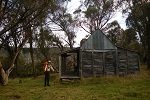Other than delicious, does anyone know what these yabbies are? ie. membership in Cherax family.
Found in Blackheath area. They are very orange, even before they're cooked, which makes them incredibly easy to spot in the water.
Help identify this yabbie
Forum rules
NSW & ACT specific bushwalking discussion. Please avoid publishing details of access to sensitive areas with no tracks.
NSW & ACT specific bushwalking discussion. Please avoid publishing details of access to sensitive areas with no tracks.
7 posts
• Page 1 of 1
-

mrpotter - Atherosperma moschatum

- Posts: 97
- Joined: Mon 29 Jul, 2013 12:34 pm
- Location: Katoomba
- Region: New South Wales
- Gender: Male
Re: Help identify this yabbie
Hey mrpotter,
Have you got a clear picture of one just sitting on the ground on it's own?
Have you got a clear picture of one just sitting on the ground on it's own?
-

FootTrack - Athrotaxis cupressoides

- Posts: 286
- Joined: Wed 07 May, 2014 8:55 am
- Region: New South Wales
- Gender: Male
Re: Help identify this yabbie
Unfortunately no but I do plan to catch & eat more. They are quite large and much more tasty than Cherax destructor
-

mrpotter - Atherosperma moschatum

- Posts: 97
- Joined: Mon 29 Jul, 2013 12:34 pm
- Location: Katoomba
- Region: New South Wales
- Gender: Male
Re: Help identify this yabbie
Normally orange crayfish are in dirty water and when is clear they are blue as. At least in the terrain that you got them in, sometimes in really muddy dams they are like black and orange. A friend once relocated an orange cray to his tank and over time it changed colour. But I'd call yours about 'done', yep cooked just right and my mouth is watering. I'm starting to not like you mrpotter with gloating like that
Cheers Walkon
"I live in a very small house, but my windows look out on a very large world."
"I live in a very small house, but my windows look out on a very large world."
-

walkon - Phyllocladus aspleniifolius

- Posts: 803
- Joined: Sun 24 Nov, 2013 7:03 am
- Region: Victoria
- Gender: Male
Re: Help identify this yabbie
Well the interesting thing is I've located them in two different streams which have different origins. The water in one used to be quite polluted but these days both are extremely clean, you could drink them without a filter (if you're mad or desperate)
Weekend before last I found a pool only about 4 x 4 metres, and counting the yabbies I could see, I lost count at 30. Most of those were under size but I could've easily gotten the bag limit for several people on some great sized ones.
Weekend before last I found a pool only about 4 x 4 metres, and counting the yabbies I could see, I lost count at 30. Most of those were under size but I could've easily gotten the bag limit for several people on some great sized ones.
-

mrpotter - Atherosperma moschatum

- Posts: 97
- Joined: Mon 29 Jul, 2013 12:34 pm
- Location: Katoomba
- Region: New South Wales
- Gender: Male
Re: Help identify this yabbie
I don't have much idea myself and on consulting Dr Google I couldn't find a lot either. It does seem there are quite a few species of freshwater crayfish in Australia/NSW though. One thing I did stumble across was this interesting presentation  http://www.bmcc.nsw.gov.au/download.cfm ... 102C4781ED. Might be of some help for next time. Without being a preacher it could be a good idea to check with an expert as well just to make sure you haven't found yourself an endangered one - seems like there a quite a few in Australia that are on the decline unfortunately
http://www.bmcc.nsw.gov.au/download.cfm ... 102C4781ED. Might be of some help for next time. Without being a preacher it could be a good idea to check with an expert as well just to make sure you haven't found yourself an endangered one - seems like there a quite a few in Australia that are on the decline unfortunately  One species in that slideshow apparently takes 7-9 years to reach sexual maturity, lays eggs once a year and lives to between 30-100 years old. Pretty unreal. Not sure what their numbers are like though...
One species in that slideshow apparently takes 7-9 years to reach sexual maturity, lays eggs once a year and lives to between 30-100 years old. Pretty unreal. Not sure what their numbers are like though...
-

FootTrack - Athrotaxis cupressoides

- Posts: 286
- Joined: Wed 07 May, 2014 8:55 am
- Region: New South Wales
- Gender: Male
Re: Help identify this yabbie
Thats is a great link you provided, thanks! They're definitely euastacus and not cherax, probably australasiensis, if not, spinifier.
IUCN lists them threatened at "least concern", which is a lower priority than minke whale, or god forbid, southern bluefin tuna. However they can and probably are bread in captivity, unlike tuna. However sufficient data for a classification doesn't exist, apparently
IUCN lists them threatened at "least concern", which is a lower priority than minke whale, or god forbid, southern bluefin tuna. However they can and probably are bread in captivity, unlike tuna. However sufficient data for a classification doesn't exist, apparently
-

mrpotter - Atherosperma moschatum

- Posts: 97
- Joined: Mon 29 Jul, 2013 12:34 pm
- Location: Katoomba
- Region: New South Wales
- Gender: Male
7 posts
• Page 1 of 1
Return to New South Wales & ACT
Who is online
Users browsing this forum: Google Adsense [Bot] and 11 guests
